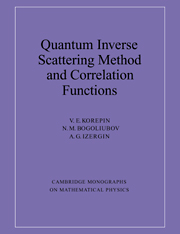Book contents
- Frontmatter
- Contents
- Preface
- Part I The Coordinate Bethe Ansatz
- Part II The Quantum Inverse Scattering Method
- Introduction to Part II
- V The Classical r-matrix
- VI The Quantum Inverse Scattering Method
- VII The Algebraic Bethe Ansatz
- VIII Lattice Integrable Models of Quantum Field Theory
- Part III The Determinant Representation for Quantum Correlation Functions
- Part IV Differential Equations for Quantum Correlation Functions
- Final Conclusion
- References
- Index
VII - The Algebraic Bethe Ansatz
Published online by Cambridge University Press: 04 August 2010
- Frontmatter
- Contents
- Preface
- Part I The Coordinate Bethe Ansatz
- Part II The Quantum Inverse Scattering Method
- Introduction to Part II
- V The Classical r-matrix
- VI The Quantum Inverse Scattering Method
- VII The Algebraic Bethe Ansatz
- VIII Lattice Integrable Models of Quantum Field Theory
- Part III The Determinant Representation for Quantum Correlation Functions
- Part IV Differential Equations for Quantum Correlation Functions
- Final Conclusion
- References
- Index
Summary
Introduction
The algebraic Bethe Ansatz is presented in this chapter. This is an important generalization of the coordinate Bethe Ansatz presented in Part I, and is one of the essential achievements of QISM. The algebraic Bethe Ansatz is based on the idea of constructing eigenfunctions of the Hamiltonian via creation and annihilation operators acting on a pseudovacuum. The matrix elements of the monodromy matrix play the role of these operators. The transfer matrix (the sum of the diagonal elements of the monodromy matrix) commutes with the Hamiltonian; thus constructing eigenfunctions of τ(µ) determines the eigenfunctions of the Hamiltonian.
The basis of the algebraic Bethe Ansatz is stated in section 1. The commutation relations between matrix elements of the monodromy matrix are specified by the R-matrix. The explicit form of the commutation relations allows the construction of eigenfunctions of the transfer matrix (the trace of the monodromy matrix). (Recall that the Hamiltonian may also be obtained from the transfer matrix via the trace identities.) Further developments of the algebraic Bethe Ansatz necessary for the computation of correlation functions are given in section 2. The general scheme is illustrated with some examples in section 3. The NS model, the sine-Gordon model and spin models are considered in detail. The Pauli principle for interacting one-dimensional bosons plays an important role in constructing the ground state of the system and is discussed in section 4. The eigenvalues of the shift operator acting on the monodromy matrix are calculated in section 5.
- Type
- Chapter
- Information
- Quantum Inverse Scattering Method and Correlation Functions , pp. 137 - 171Publisher: Cambridge University PressPrint publication year: 1993

